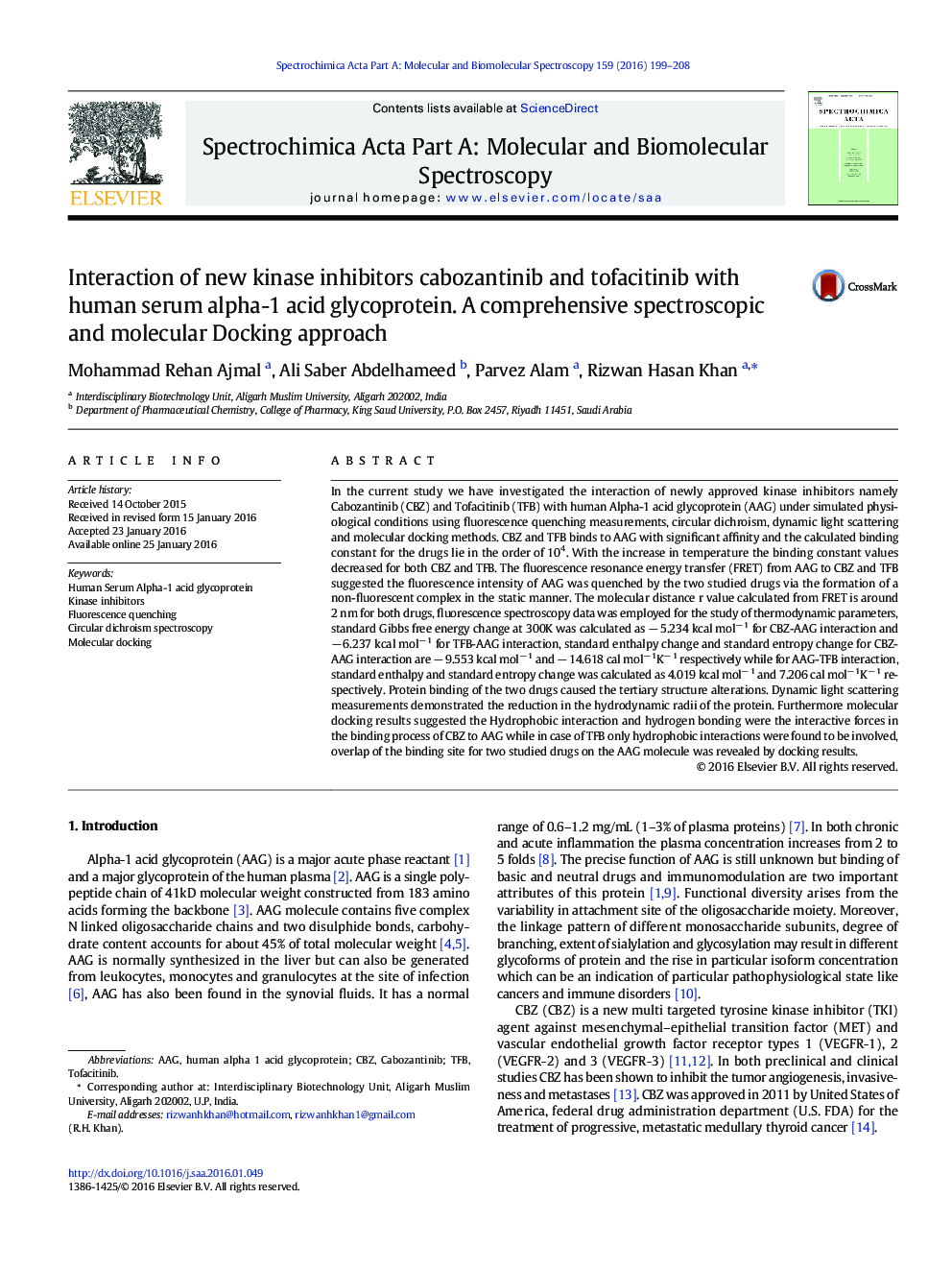| کد مقاله | کد نشریه | سال انتشار | مقاله انگلیسی | نسخه تمام متن |
|---|---|---|---|---|
| 1228938 | 1495210 | 2016 | 10 صفحه PDF | دانلود رایگان |

• Cabozantinib (CBZ) and Tofacitinib (TFB) are kinase inhibitors and anticancer drugs, binding process to human Alpha-1 acid glycoprotein (AAG) under simulated physiological conditions were studied.
• Alpha-1 acid glycoprotein (AAG) is a major acute phase reactant, a major glycoprotein of the human plasma.
• Binding mode is static. Binding constants for the two drugs with AAG lie in the order of 104, Ksv and Kb values decreased with increasing temperature suggesting static mode of fluorescence quenching is operative in the two drugs.
• Protein binding of the two drugs caused the tertiary structure alterations in the protein. Dynamic light scattering measurements demonstrated the reduction in the hydrodynamic radii of the protein.
• Overlap of the binding site for two studied drugs on the AAG molecule was revealed by docking results.
In the current study we have investigated the interaction of newly approved kinase inhibitors namely Cabozantinib (CBZ) and Tofacitinib (TFB) with human Alpha-1 acid glycoprotein (AAG) under simulated physiological conditions using fluorescence quenching measurements, circular dichroism, dynamic light scattering and molecular docking methods. CBZ and TFB binds to AAG with significant affinity and the calculated binding constant for the drugs lie in the order of 104. With the increase in temperature the binding constant values decreased for both CBZ and TFB. The fluorescence resonance energy transfer (FRET) from AAG to CBZ and TFB suggested the fluorescence intensity of AAG was quenched by the two studied drugs via the formation of a non-fluorescent complex in the static manner. The molecular distance r value calculated from FRET is around 2 nm for both drugs, fluorescence spectroscopy data was employed for the study of thermodynamic parameters, standard Gibbs free energy change at 300K was calculated as − 5.234 kcal mol− 1 for CBZ-AAG interaction and − 6.237 kcal mol− 1 for TFB-AAG interaction, standard enthalpy change and standard entropy change for CBZ-AAG interaction are − 9.553 kcal mol− 1 and − 14.618 cal mol− 1K− 1 respectively while for AAG-TFB interaction, standard enthalpy and standard entropy change was calculated as 4.019 kcal mol− 1 and 7.206 cal mol− 1K− 1 respectively. Protein binding of the two drugs caused the tertiary structure alterations. Dynamic light scattering measurements demonstrated the reduction in the hydrodynamic radii of the protein. Furthermore molecular docking results suggested the Hydrophobic interaction and hydrogen bonding were the interactive forces in the binding process of CBZ to AAG while in case of TFB only hydrophobic interactions were found to be involved, overlap of the binding site for two studied drugs on the AAG molecule was revealed by docking results.
Figure optionsDownload as PowerPoint slide
Journal: Spectrochimica Acta Part A: Molecular and Biomolecular Spectroscopy - Volume 159, 15 April 2016, Pages 199–208